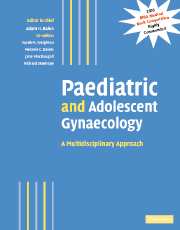Book contents
- Frontmatter
- Contents
- Contributors
- Preface
- Part I Normal development
- Part II Management of developmental abnormalities of the genital tract
- 9 Management of ambiguous genitalia at birth
- 10 Imaging of the female pelvis in the evaluation of developmental anomalies
- 11 Surgical correction of vaginal and other anomalies
- 12 Laparoscopic techniques
- 13 A nonsurgical approach to the treatment of vaginal agenesis
- 14 Psychological care in disorders of sexual differentiation and determination
- 15 The needs of the adolescent patient and her parents in the clinic
- 16 Communicating a diagnosis
- 17 Patients and parents in decision making and management
- Part III Management of specific disorders
- Index
- Plate section
- References
12 - Laparoscopic techniques
from Part II - Management of developmental abnormalities of the genital tract
Published online by Cambridge University Press: 04 May 2010
- Frontmatter
- Contents
- Contributors
- Preface
- Part I Normal development
- Part II Management of developmental abnormalities of the genital tract
- 9 Management of ambiguous genitalia at birth
- 10 Imaging of the female pelvis in the evaluation of developmental anomalies
- 11 Surgical correction of vaginal and other anomalies
- 12 Laparoscopic techniques
- 13 A nonsurgical approach to the treatment of vaginal agenesis
- 14 Psychological care in disorders of sexual differentiation and determination
- 15 The needs of the adolescent patient and her parents in the clinic
- 16 Communicating a diagnosis
- 17 Patients and parents in decision making and management
- Part III Management of specific disorders
- Index
- Plate section
- References
Summary
Introduction
The first gynaecological reports for laparoscopy came from Hope in 1937 (Hope, 1937) on the diagnosis of extrauterine pregnancy but it was not until the 1970s that laparoscopic surgery started to become established (Semm, 1970). The introduction of good-resolution camera systems and the development of new surgical instruments have enabled the advancement of laparoscopic surgery. In addition, advances in technology have increased the safety parameters and enabled surgery to be performed more efficiently. These technological developments include the expansion of bipolar technology and the introduction of laser modalities, the harmonic scalpel and haemostatic stapling devices.
Originally laparoscopic surgery was referred to as minimally invasive surgery but it soon became apparent that the surgery was highly invasive but performed through small incisions, and hence the term minimal access surgery was coined. Minimal access surgery can be considered as an alternative procedure to the traditional operation; it aims to achieve the same end result as the traditional operation but is performed through small incisions. In hysteroscopic surgery, most laparoscopic procedures should aim to emulate the open operation, the only difference being the size of the incision. However, there may be modifications in the minimal access route as a result of the improved vision that it affords or the difficulty in emulating the open procedure. The perceived disadvantages of the laparoscopic route over the open route are the potential complications, the time to perform the operation and the cost.
- Type
- Chapter
- Information
- Paediatric and Adolescent GynaecologyA Multidisciplinary Approach, pp. 131 - 146Publisher: Cambridge University PressPrint publication year: 2004



